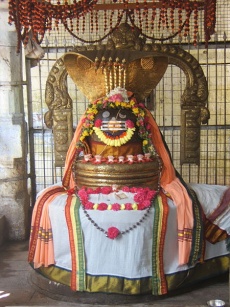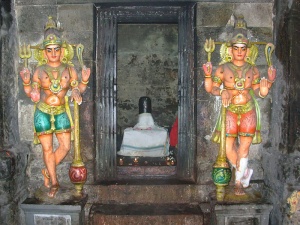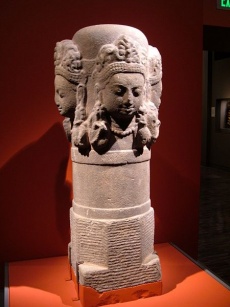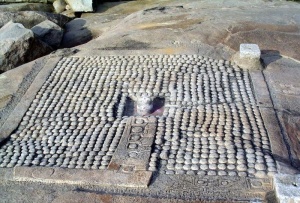Lingam
[[File:Aikya Linga in Varanasi.jpg|thumb|Traditional flower offering to a lingam in Varanasi)]
The lingam (also, linga, ling, Shiva linga, Shiv ling, Sanskrit लिङ्गं, liṅgaṃ, meaning "mark", "sign", "inference" or) is a representation of the Hindu deity Shiva used for worship in temples.
In traditional Indian society, the linga is rather seen as a symbol of the energy and potentiality of the God.
The lingam is often represented alongside the yoni, a symbol of the goddess or of Shakti, female creative energy.
The union of lingam and yoni represents the "indivisible two-in-oneness of male and female, the passive space and active time from which all life originates".
Definition and meaning
[[File:Linga-Yoni.jpg|thumbnail|right|Linga-base at the Cát Tiên sanctuary, Lâm Đồng Province, Vietnam)]
The Sanskrit term लिङ्गं liṅgaṃ, transliterated as linga, has diverse meanings and uses, ranging from mark, sign or characteristic to gender. Vaman Shivram Apte's Sanskrit dictionary provides the many definitions:
- A mark, sign, token, an emblem, a badge, symbol, distinguishing mark, characteristic;
- A symptom, mark of disease
- A means of proof, a proof, evidence
- In logic, the hetu or middle term in a syllogism
- In grammar, gender
- The image of a god, an idol
- One of the relations or indications which serve to fix the meaning of a word in any particular passage
- In Vedānta philosophy, the subtle frame or body, the indestructible original of the gross or visible body
- A spot or stain
- The nominal base, the crude form of a noun
- In Sāk philosophy, Pradhāna or Prakriti
- The effect or product of evolution from a primary cause and also as the producer
- Inference, conclusion
The Hindu scripture Shiva Purana describes in its first section, the Vidyeshwar Samhita, the origin of the lingam, known as Shiva-linga, as the beginning-less and endless cosmic pillar (Stambha) of fire, the cause of all causes.
Lord Shiva is pictured as emerging from the Lingam – the cosmic pillar of fire – proving his superiority over gods Brahma and Vishnu. This is known as Lingodbhava.
The Linga Purana also supports this interpretation of lingam as a cosmic pillar, symbolizing the infinite nature of Shiva.
According to Linga Purana, Shiva लिङ्गं liṅgaṃ Shiva Lingam or Shiva Pindi is a complete symbolic representation of the formless Universe Bearer - the oval shaped stone is resembling mark of the Universe and bottom base as the Supreme Power holding the entire Universe in it.
Similar interpretation is also found in the Skanda Purana: "The endless sky (that great void which contains the entire universe) is the Linga, the Earth is its base. At the end of time the entire universe and all the Gods finally emerge in the Linga itself."
History
Origin
Anthropologist Christopher John Fuller conveys that although most sculpted images (murtis) are anthropomorphic, the aniconic Shiva Linga is an important exception.
Some believe that linga-worship was a feature of indigenous Indian religion.
There is a hymn in the Atharvaveda which praises a pillar (Sanskrit: stambha), and this is one possible origin of linga-worship.
Some associate Shiva-Linga with this Yupa-Stambha, the sacrificial post.
In that hymn a description is found of the beginningless and endless Stambha or Skambha and it is shown that the said Skambha is put in place of the eternal Brahman.
As afterwards the Yajna (sacrificial) fire, its smoke, ashes and flames, the soma plant and the ox that used to carry on its back the wood for the Vedic sacrifice gave place to the conceptions of the brightness of Shiva's body, his tawny matted-hair, his blue throat and the riding on the bull of the Shiva.
The Yupa-Skambha gave place in time to the Shiva-Linga.
In the Linga Purana the same hymn is expanded in the shape of stories, meant to establish the glory of the great Stambha and the supreme nature of Mahâdeva (the Great God, Shiva).
Historical period

According to Shaiva Siddhanta, which was for many centuries the dominant school of Shaiva theology and liturgy across the Indian subcontinent (and beyond it in Cambodia), the linga is the ideal substrate in which the worshipper should install and worship the five-faced and ten-armed Sadāśiva, the form of Shiva who is the focal divinity of that school of Shaivism.
The oldest example of a lingam which is still used for worship is in Gudimallam.
According to Klaus Klostermaier, it is clearly a phallic object, and dates to the 2nd century BC. A figure of Shiva is carved into the front of the lingam.
Modern period
British missionary William Ward criticized the worship of the lingam (along with virtually all other Indian religious rituals) in his influential 1815 book A View of the History, Literature, and Mythology of the Hindoos, calling it "the last state of degradation to which human nature can be driven", and stating that its symbolism was "too gross, even when refined as much as possible, to meet the public eye."
According to Brian Pennington, Ward's book "became a centerpiece in the British construction of Hinduism and in the political and economic domination of the subcontinent."
In 1825, however, Horace Hayman Wilson's work on the 'lingayat' sect of South India attempted to refute popular British notions that the lingam graphically represented a human organ and that it aroused erotic emotions in its devotees.
Monier-Williams wrote in Brahmanism and Hinduism that the symbol of linga is "never in the mind of a Saiva (or Siva-worshipper) connected with indecent ideas, nor with sexual love."
According to Jeaneane Fowler, the linga is "a phallic symbol which represents the potent energy which is manifest in the cosmos."
Some scholars, such as David James Smith, believe that throughout its history the lingam has represented the phallus; others, such as N. Ramachandra Bhatt, believe the phallic interpretation to be a later addition. M. K. V. Narayan distinguishes the Siva-linga from anthropomorphic representations of Siva, and notes its absence from Vedic literature, and its interpretation as a phallus in Tantric sources.
Ramakrishna practiced Jivanta-linga-puja, or "worship of the living lingam".
At the Paris Congress of the History of Religions in 1900, Ramakrishna's follower Swami Vivekananda argued that the Shiva-Linga had its origin in the idea of the Yupa-Stambha or Skambha—the sacrificial post, idealized in Vedic ritual as the symbol of the Eternal Brahman.
This was in response to a paper read by Gustav Oppert, a German Orientalist, who traced the origin of the Shalagrama-Shila and the Shiva-Linga to phallicism.
According to Vivekananda, the explanation of the Shalagrama-Shila as a phallic emblem was an imaginary invention. Vivekananda argued that the explanation of the Shiva-Linga as a phallic emblem was brought forward by the most thoughtless, and was forthcoming in India in her most degraded times, those of the downfall of Buddhism.
According to Swami Sivananda, the view that the Shiva lingam represents the phallus is a mistake;
The same sentiments have also been expressed by H. H. Wilson in 1840. The novelist Christopher Isherwood also addresses the interpretation of the linga as a sex symbol.
The Britannica encyclopedia entry on lingam also notes that the lingam is not considered to be a phallic symbol;
Wendy Doniger, an American scholar of the history of religions, states:
- For Hindus, the phallus in the background, the archetype (if I may use the word in its Eliadean, indeed Bastianian, and non-Jungian sense) of which their own penises are manifestations, is the phallus (called the lingam) of the god Siva, who inherits much of the mythology of Indra (O'Flaherty, 1973).
The lingam appeared, separate from the body of Siva, on several occasions... On each of these occasions, Siva's wrath was appeased when gods and humans promised to worship his lingam forever after, which, in India they still do.
Hindus, for instance, will argue that the lingam has nothing whatsoever to do with the male sexual organ, an assertion blatantly contradicted by the material.
Professor Doniger clarified her viewpoints in a later book, The Hindus: An Alternative History, by noting that some texts treat the linga as an aniconic pillar of light or an as an abstract symbol of God with no sexual reference and comments on the varying interpretations of the linga from phallic to abstract.
According to Hélène Brunner, the lines traced on the front side of the linga, which are prescribed in medieval manuals about temple foundation and are a feature even of modern sculptures, appear to be intended to suggest a stylised glans,
and some features of the installation process seem intended to echo sexual congress. Scholars like S. N. Balagangadhara have disputed the sexual meaning of lingam.
Naturally occurring lingams
[[File:Lord Amarnath.jpg|right|thumb|Lingam in the cave at Amarnath)] An ice lingam at Amarnath in the western Himalayas forms every winter from ice dripping on the floor of a cave and freezing like a stalagmite. It is very popular with pilgrims.
Shivling (6543m) is also a mountain in Uttarakhand (the Garhwal region of Himalayas).
It arises as a sheer pyramid above the snout of the Gangotri Glacier.
The mountain resembles a Shiva linga when viewed from certain angles, especially when travelling or trekking from Gangotri to Gomukh as a part of a traditional Hindu pilgrimage.



